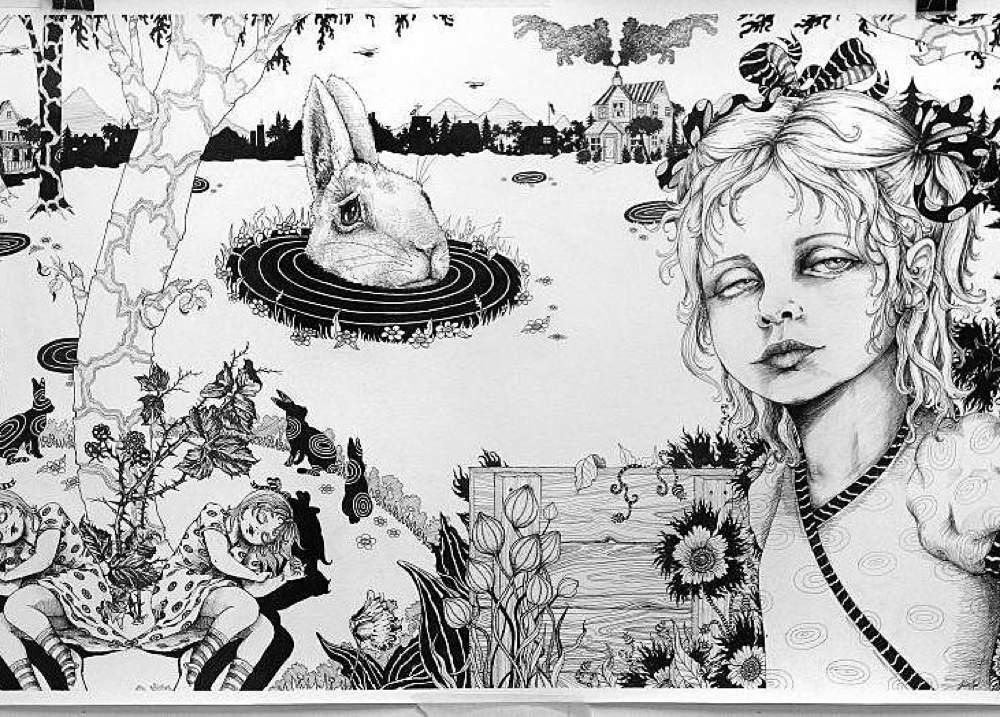Wonderland, it's beautiful
22.1. —
6.3.2005
The group show Wonderland, it’s beautiful marries four artistic positions — those of three painters, i.e. Lise Blomberg Andersen (born in1971, lives in Copenhagen), Trine Boesen (born in1972, lives in Copenhagen), and Julie Nord (born in 1970, lives in Copenhagen), and of one installation artist, i.e. Tiina Ketara from Finland (born in 1965, lives in Paris and Helsinki).
What the works created by these four artists have in common is their preoccupation with fairytales, romantic illusions, magical make-believe worlds, dream-like fragments, enchanted nature, and mental landscapes. At first sight, their beauty is alluring and intoxicating, but when viewed more closely they are forever on the verge of turning into something arguably terrifying and perilous. The works play with the evocation of psychologizing moments — the stories alluded to dissolve into ambiguity.
Text from Sabine Schaschl

Lise Blomberg Andersen’s figurative pictures, for example, conjure up a wealth of stories, but it quickly turns out that the narration she hints at remains stationary. The painted scenes are reminiscent of frozen stills, or cutouts taken from a larger unaccounted-for context. The artist frequently uses one motif — a hybrid between a bird and a human being. It has a humorous, cheerful air to it but there is also a darker side, something which elicits somber feelings and fear. The bird-woman from Greek mythology offers her assistance as people enter the realm of the dead.

An abundance of signs and symbols taken from everyday life clashes in the paintings by Trine Boesen, who embeds these elements amidst finely drawn tangles of lines and virtual explosions of color. Boesen often combines urban elements and buildings with fragile-looking elements of nature. In the manner of a DJ, Boesen produces samplers from magazines, film footage, her personal photo album, and from everyday life. All these parts are joined to form a collage, and this eventually results in a painted motif. Individual pictorial elements whirl around as if in parallel universes. In Kunsthaus Baselland the artist also incorporates the space surrounding her pictures. By painting decorative, floral designs applied directly onto the wall, Boesen generates a décor in which her collage-like and proliferating paintings take hold of the adjacent wall as well.

Tiina Ketara’s most recent works are hanging sculptures made of glass or plastic beads. The artist first generates computer models of potential sculptures, determining the sizes and colors of individual elements. In this exhibition, her sculpture comprises strings of beads on transparent nylon threads hanging from the ceiling. Light, air, color, and space are of crucial importance for the visual result; these elements and a compositional differentiation between foreground and background are just as significant as for a painted picture. In Ketara’s works as well, the title adds a second meaning, one which makes us temporarily forget their apparent beauty. In her installation Mark of Blood a subtle three-dimensional landscape painting metamorphoses into a flow of blood which may embody an analytical, scientific, and model-like reconstitution of blood particles or an infectious entity. A sacral meaning can be found primarily in works such as Stairs. The beads (transparent and in different shades of blue) form stairs that seem to rise endlessly, like a ‘stairway to heaven’.

Julie Nord’s ink drawings and paintings explore a surreal world, a universe of fairytales. They captivate the viewers’ attention as soon as they lay their eyes on them for the first time. Nord’s painting exudes an almost apocalyptical,end-of-days atmosphere. While initially the moths appear to be entirely harmless and quite lovely, they quickly turn into something menacing, a foreboding of a sinister deed to be done. In a comprehensive series of drawings, Julie Nord takes Lewis Carroll’s Alice in Wonderland and Through the Looking Glass as her points of departure. Nothing is interpreted literally; individual scenes dissolve into or delete others. The gaps existing in some drawings may be construed as patches of mental landscapes. They lend themselves well to be filled with personal thoughts. Nord’s ink drawings and paintings abound with idiosyncrasies of various kinds and follow an inherent narrative logic; its only connections to the real world outside are recognizable objects, animals, and human figures.
